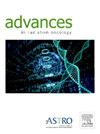体积调节电弧治疗难治性、皮质类固醇抵抗性眼窝炎性疾病的疗效
IF 2.7
Q3 ONCOLOGY
引用次数: 0
摘要
目的本研究旨在评估体积调节弧线疗法(VMAT)治疗皮质类固醇抵抗性眼窝炎的有效性和安全性,重点研究放射治疗(RT)方案设计、临床结果和治疗相关副作用的发生率。方法与材料回顾性分析2019年11月至2022年7月57例经VMAT治疗的难治性、糖皮质激素抵抗性眼眶炎症性疾病患者。主要终点是RT后皮质类固醇使用的减少或停止,次要终点包括眼部临床症状(复视、眼球突出、视力和眼外运动)的改善和长期副作用。结果中位靶剂量为20 Gy,晶状体平均照射剂量为5.4 Gy。最初,所有57名患者都接受了皮质类固醇治疗。中位随访27.5个月后,89.5%(51 / 57)的患者对RT治疗有积极反应;特别是,56.1%(57人中32人)完全停止使用皮质类固醇,而33.3%(57人中19人)减少了剂量。复视(67.3%)、眼球突出(64.7%)、视力(56.1%)和眼外运动(65.9%)的症状均有改善。关于放疗的长期副作用,干眼综合征和晶状体混浊的发生率分别为3.5%和1.8%。结论索必妥VMAT治疗难治性、糖皮质激素抵抗性眼窝炎有效,减少糖皮质激素的使用,改善眼部症状,且副作用小。需要进一步的前瞻性临床试验来验证更合适的VMAT剂量和计划模型,在不增加RT副作用的情况下提高治疗效果。本文章由计算机程序翻译,如有差异,请以英文原文为准。
Outcomes of Volumetric-Modulated Arc Therapy for Refractory, Corticosteroid-Resistant Orbital Inflammatory Diseases
Purpose
This study aimed to evaluate the efficacy and safety of volumetric-modulated arc therapy (VMAT) in treating corticosteroid-resistant orbital inflammatory diseases, with a focus on radiation therapy (RT) plan design, clinical outcomes, and the incidence of treatment-related side effects.
Methods and Materials
A retrospective analysis was conducted on 57 patients with refractory, corticosteroid-resistant orbital inflammatory diseases treated with orbital VMAT from November 2019 to July 2022. The primary endpoint was the reduction or cessation of corticosteroid use following RT, with secondary endpoints, including improvements in ocular clinical symptoms (diplopia, proptosis, visual acuity, and extraocular movement) and long-term side effects.
Results
The median target dose was 20 Gy, with an average lens irradiation dose of 5.4 Gy. Initially, all 57 patients received corticosteroids. After a median follow-up of 27.5 months, 89.5% (51 of 57) of patients responded positively to RT; in particular, 56.1% (32 of 57) completely tapered off corticosteroids, whereas 33.3% (19 of 57) reduced their dosage. Symptomatic improvements were observed in diplopia (67.3%), proptosis (64.7%), visual acuity (56.1%), and extraocular movements (65.9%). Regarding the long-term side effects of RT, incidences of dry eye syndrome and lens opacities were reported at 3.5% and 1.8%, respectively.
Conclusions
Orbital VMAT is an effective treatment for refractory, corticosteroid-resistant orbital inflammatory diseases, reducing corticosteroid use and improving ocular symptoms with minimal side effects. Further prospective clinical trials are warranted to validate more appropriate VMAT doses and planning models, enhancing treatment outcomes without increasing RT side effects.
求助全文
通过发布文献求助,成功后即可免费获取论文全文。
去求助
来源期刊

Advances in Radiation Oncology
Medicine-Radiology, Nuclear Medicine and Imaging
CiteScore
4.60
自引率
4.30%
发文量
208
审稿时长
98 days
期刊介绍:
The purpose of Advances is to provide information for clinicians who use radiation therapy by publishing: Clinical trial reports and reanalyses. Basic science original reports. Manuscripts examining health services research, comparative and cost effectiveness research, and systematic reviews. Case reports documenting unusual problems and solutions. High quality multi and single institutional series, as well as other novel retrospective hypothesis generating series. Timely critical reviews on important topics in radiation oncology, such as side effects. Articles reporting the natural history of disease and patterns of failure, particularly as they relate to treatment volume delineation. Articles on safety and quality in radiation therapy. Essays on clinical experience. Articles on practice transformation in radiation oncology, in particular: Aspects of health policy that may impact the future practice of radiation oncology. How information technology, such as data analytics and systems innovations, will change radiation oncology practice. Articles on imaging as they relate to radiation therapy treatment.
 求助内容:
求助内容: 应助结果提醒方式:
应助结果提醒方式:


